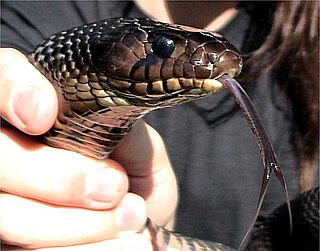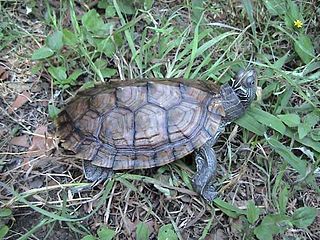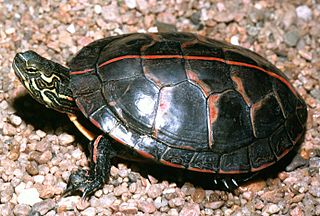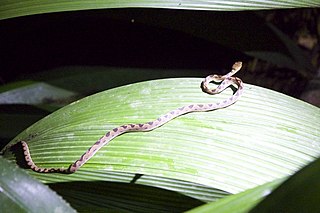Crocodilians
| Picture | Scientific name | Common name | Family | Conservation status |
|---|---|---|---|---|
| Family: Alligatoridae (alligators and caimans) | ||||
 | Alligator mississippiensis | American alligator | Alligatoridae | IUCN (LC) |
This list of reptiles of Texas includes the snakes, lizards, crocodilians, and turtles native to the U.S. state of Texas.
Texas has a large range of habitats, from swamps, coastal marshes and pine forests in the east, rocky hills and limestone karst in the center, desert in the south and west, mountains in the far west, and grassland prairie in the north. This vast contrast in biomes makes Texas home to an extremely wide variety of herpetofauna. Its central position in the United States means that species found primarily in either the western or eastern parts of the country often have their ranges meeting in the state. Its proximity to Mexico is such that many species found there and into Central America range as far north as Texas. The abundance of reptiles makes the state a prime area for research, and most species found in Texas have been well studied.
Texas state law protects several reptile species; threatened species are denoted with a (T) and endangered species are denoted with an (E). The climate of Texas has also led to some species being introduced and establishing a permanent population, denoted with an (I).
| Least-concern species | |
| Vulnerable species | |
| Endangered species | |
| Critically endangered | |
| Invasive species |
| Picture | Scientific name | Common name | Family | Conservation status |
|---|---|---|---|---|
| Family: Alligatoridae (alligators and caimans) | ||||
 | Alligator mississippiensis | American alligator | Alligatoridae | IUCN (LC) |

Herpetology is a branch of zoology concerned with the study of amphibians and reptiles. Birds, which are cladistically included within Reptilia, are traditionally excluded here; the separate scientific study of birds is the subject of ornithology.

The eastern copperhead, also known simply as the copperhead, is a species of venomous snake, a pit viper, endemic to eastern North America; it is a member of the subfamily Crotalinae in the family Viperidae.

The painted turtle is the most widespread native turtle of North America. It lives in relatively slow-moving fresh waters, from southern Canada to northern Mexico, and from the Atlantic to the Pacific. They have been shown to prefer large wetlands with long periods of inundation and emergent vegetation. This species is one of the few that is specially adapted to tolerate freezing temperatures for extended periods of time due to an antifreeze-like substance in their blood that keeps their cells from freezing. This turtle is a member of the genus Chrysemys, which is part of the pond turtle family Emydidae. Fossils show that the painted turtle existed 15 million years ago. Three regionally based subspecies evolved during the last ice age. The southern painted turtle (C. dorsalis) is alternately considered the only other species in Chrysemys, or another subspecies of C. picta.

The chicken turtle is a turtle native to the southeastern United States. It is the only extant member of the genus Deirochelys and is a member of the freshwater marsh turtle family Emydidae. The chicken turtle's scientific name refers to its extremely long neck and distinctive net-like pattern on its upper shell. There are three regionally distinct subspecies, which are thought to have evolved when populations became separated during periods of glaciation. These subspecies can be distinguished by their appearance; the western chicken turtle displays dark markings along the seams of its plastron, while the plastron of the Florida subspecies is a bright yellow or orange color. Fossil records show that the chicken turtle has been present in the region for up to five million years.

Pseudemys is a genus of large, herbivorous, freshwater turtles of the eastern United States and adjacent northeast Mexico. They are often referred to as cooters, which stems from kuta, the word for turtle in the Bambara and Malinké languages, brought to America by enslaved people from Africa.

James Ray Dixon was professor emeritus and curator emeritus of amphibians and reptiles at the Texas Cooperative Wildlife Collection at Texas A&M University. He lived in El Campo, Texas, throughout most of his childhood. He published prolifically on the subject of herpetology in his distinguished career, authoring and co-authoring several books, book chapters, and numerous peer reviewed notes and articles, describing two new genera, and many new species, earning him a reputation as one of the most prominent herpetologists of his generation. His main research focus was morphology based systematics of amphibians and reptiles worldwide with emphasis on Texas, US, Mexico, Central America, and South America, although bibliographies, conservation, ecology, life history and zoogeography have all been the subjects of his extensive publications.

Drymarchon melanurus erebennus, commonly known as the Texas indigo snake, is a subspecies of large, nonvenomous snake in the family Colubridae. The subspecies is native to Texas in the United States and adjacent Mexico.

The Texas garter snake is a subspecies of the common garter snake. The subspecies, which belongs to the subfamily Natricinae of the family Colubridae, is native to the western United States.

Graptemys is a genus of freshwater turtles containing 14 species, commonly known as map turtles. Graptemys are small to medium-sized turtles that are significantly sexually dimorphic, with females in some species attaining as much as twice the length and ten times the mass as males. Depending on the species, adult males range from 7–16 cm (2.75–6.25 in), adult females 10–29.5 cm (4–11.62 in), and hatchlings 2.5–3.8 cm (1–1.5 in), although some sources indicate female Barbour's map turtles grow to 33 cm (13 in) in length. Most species have a distinctive dark pigmented keel that is often notched or serrated running down the center of the carapace and serrated scutes on the rear margin. The head, neck, and limbs exhibit bold patterns of yellow lines and spots against darker green, olive, or black base colors. The patterns on the head can be important characters in identifying the various species. The common name "map turtle" is derived from the intricate patterns on their shells that are suggestive of topographical maps, although the patterns are more apparent in some species than others, and often become obscure in older specimens. Some species are occasionally called "sawbacks", in reference to the serrated keels on their shell.
Hobart Muir Smith, born Frederick William Stouffer, was an American herpetologist. He is credited with describing more than 100 new species of American reptiles and amphibians. In addition, he has been honored by having at least six species named after him, including the southwestern blackhead snake, Smith's earth snake, Smith's arboreal alligator lizard, Hobart's anadia, Hobart Smith's anole, and Smith's rose-bellied lizard. At 100 years of age, Smith continued to be an active and productive herpetologist. Although he published on a wide range of herpetological subjects, his main focus throughout his career was on the amphibians and reptiles of Mexico, including taxonomy, bibliographies, and history. Having published more than 1,600 manuscripts, he surpassed all contemporaries and remains the most published herpetologist of all time.

Virginia striatula, commonly called the rough earth snake, is a species of nonvenomous natricine colubrid snake native to the Southeastern United States.

Drymobius margaritiferus, commonly known as the speckled racer, is a species of nonvenomous colubrid snake native to the Americas. The specific name, margaritiferus, means "pearl-bearing" in Latin, referring to the pearl-like spots on the dorsal scales.

The Rio Grande cooter is a species of turtle in the family Emydidae. The species is native to northeastern Mexico and the adjacent southwestern United States.
J. Whitfield "Whit" Gibbons is an American herpetologist, author, and educator. He is Professor Emeritus of Ecology, University of Georgia, and former Head of the Environmental Outreach and Education program at the Savannah River Ecology Laboratory (SREL).

The southern painted turtle is a species of turtle in the family Emydidae. It is endemic to the south-central United States.
Lee Fitzgerald is Professor of Zoology and Faculty Curator of Amphibians and Reptiles in the Department of Wildlife and Fisheries Sciences at Texas A&M University. His biological specialty is the evolutionary ecology and conservation biology of amphibians and reptiles (herpetology). Fitzgerald is a former editor of Herpetological Monographs.
Walter E. Meshaka Jr. is an American herpetologist and natural historian. He was the supervisory curator for the four National Parks in southern Florida from 1995 to 2000. In 2000 he became the Senior Curator of Zoology and Botany at the State Museum of Pennsylvania in Harrisburg, Pennsylvania. His research has been covered by Lawrence Journal-World, among other news outlets.

Leptodeira septentrionalis, the northern cat-eyed snake, is a species of medium-sized, slightly venomous snake, found from southern Texas to Costa Rica.